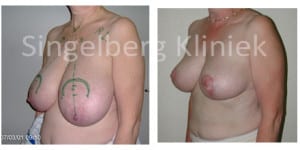Background Information on breast uplift:
Breast uplift surgery or mastopexy, restores a more youthful appearance to a woman’s breasts. Over the years breasts can lose their shape and firmness due to pregnancy, nursing and loss of skin elasticity, causing them to sag.
A breast uplift (mastopexy) can improve the appearance of the breasts in several ways. It raises the breast tissue, repositions the nipple and areola (brownish pigmentation around the nipple), and enhances breast shape. If the areola have been stretched over time, they can be reduced in size. Women who undergo a breast lift may also seek to increase the size of their breasts with a breast implant.

Procedure
Your breast uplift would usually be performed in a belgian public hospital, or a surgeon’s clinic. Breast lift surgery takes between one and a half and three and a half hours.
There are different techniques which can be used, but the surgery usually begins with the surgeon making a cut underneath your breast which follows the natural curve of the breast. He then makes another cut which runs from the nipple down towards the bottom of the breast. You might imagine the incisions which are made being like the shape of an anchor. The cut marks the area from which breast skin will be removed. When the excess skin has been removed, the nipple and areola are moved to the higher position. The skin surrounding the areola is then pulled tightly down and together to reshape the breast. Stitches are usually put in around the areola, in a line running downwards from the nipple area, and along the lower crease of the breast.
Some patients, especially those with relatively small breasts and not much sagging, may be better suited to slightly different procedures requiring fewer incisions which would reduce the scarring. One such procedure is the “doughnut (or concentric) mastopexy,” in which a circular cut is made around the areola, and a doughnut-shaped area of skin is removed. Additionally there is the “crescent” technique that involves removing a crescent-shaped piece of tissue above the areola and then just having the skin pulled up towards the top of the breast. This creates a minor lift for patients who have only slight sagging. Another technique which requires little cutting is called the “lollipop” because the incision is made around the nipple area with a line running down the breast.
If you have the “lollipop”, a third incision along the crease underneath the breast, used in traditional operations, is not necessary. In this technique, the breast tissue is built up in the middle in a “cone,” shape, bringing in breast tissue from the sides and middle of the breast. The result of this operation is that your breasts will stick out more!
Alternatively, a breast uplift may be performed using local anesthesia and intravenous sedation.
When surgery is completed, you will be taken into a recovery area where you will continue to be closely monitored. Sometimes, small drain tubes will have been placed in your breasts to help avoid the accumulation of fluids. Gauze or other dressings may be placed on your breasts and covered with an elastic bandage or surgical bra. You may be permitted to go home after a few hours, unless you and your plastic surgeon have determined that you will stay in the hospital or surgical facility overnight. The day after surgery, you will be encouraged to get out of bed for short periods of time. After several days, you should be able to move about more comfortably. Straining, bending and lifting must be avoided, however, since these activities might cause increased swelling or even bleeding. You may be instructed to sleep on your back to avoid pressure on your breasts.
Any surgical drains will be removed within a few days of surgery, at which time your dressings may also be changed or removed. You may be instructed to wear a support bra for a few weeks, until the swelling and discoloration of your breasts diminish. Generally, stitches will be removed in stages over a period of approximately three weeks, beginning about one week after surgery.
Conclusion: The best candidates for this procedure include:
Breasts that are pendulous, but of satisfactory size Breasts that lack substance or firmness
Nipples and areolas that point downward, especially if they are positioned below the breast crease
Though breasts of any size can be lifted, women with smaller breasts enjoy longer lasting results. Women with heavier breasts may need a breast reduction and an uplift.